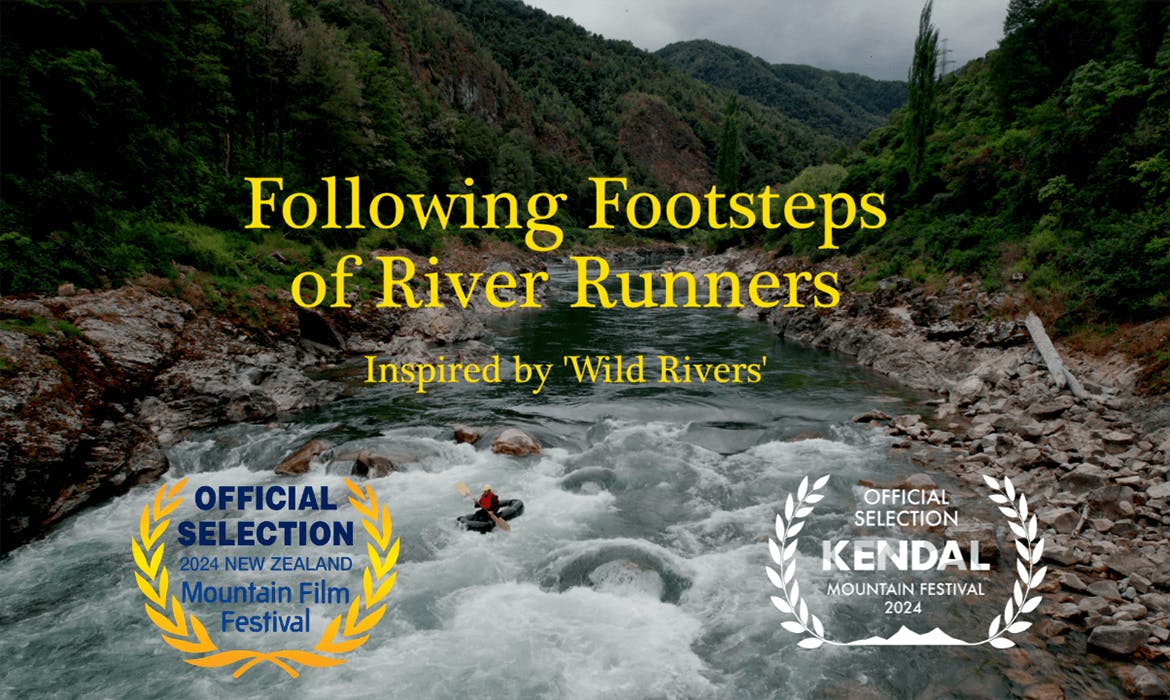Story and Film by: Deane Parker
Photos: Megan Dimozantos
Film Premiere - Watch the film now!
Taking paths previously taken, but in modern day packraft, Footsteps of River Runners is a great film shows you some of New Zealand's most challenging rivers and how they were paddled then and now. Check it out.
More on this story....
In the mid-90s I remember coming across the book Wild Rivers and being intrigued by the history and ingenuity required but also being “too cool” for school with our fancy plastic creek boats. The book details some of the author John Mackay’s earliest forays into some of the most challenging rivers in NZ in rafts made on the side of the river based around 2 truck tire inner tubes.
I was cutting my teeth on some of the same rivers as a commercial raft guide, The Clarence, Buller, and especially the Karamea. This river was the spark and catalyst for many things in my river running past. It was my first ever rafting trip cajoled into it by an ex-girlfriend and instantly entranced. It was how I gained my wings for trip-leading Class 4-5 multi-day raft trips. It was where I met my wife at the little village that sat at the coast where this magical river ended its tumultuous journey from deep within Kahurangi National Park. The river has a long catchment (by NZ standards) and a history of uses and exploration. The headwaters are close to Tasman Bay and therefore the corridor offered travel by both Maori and early Europeans.
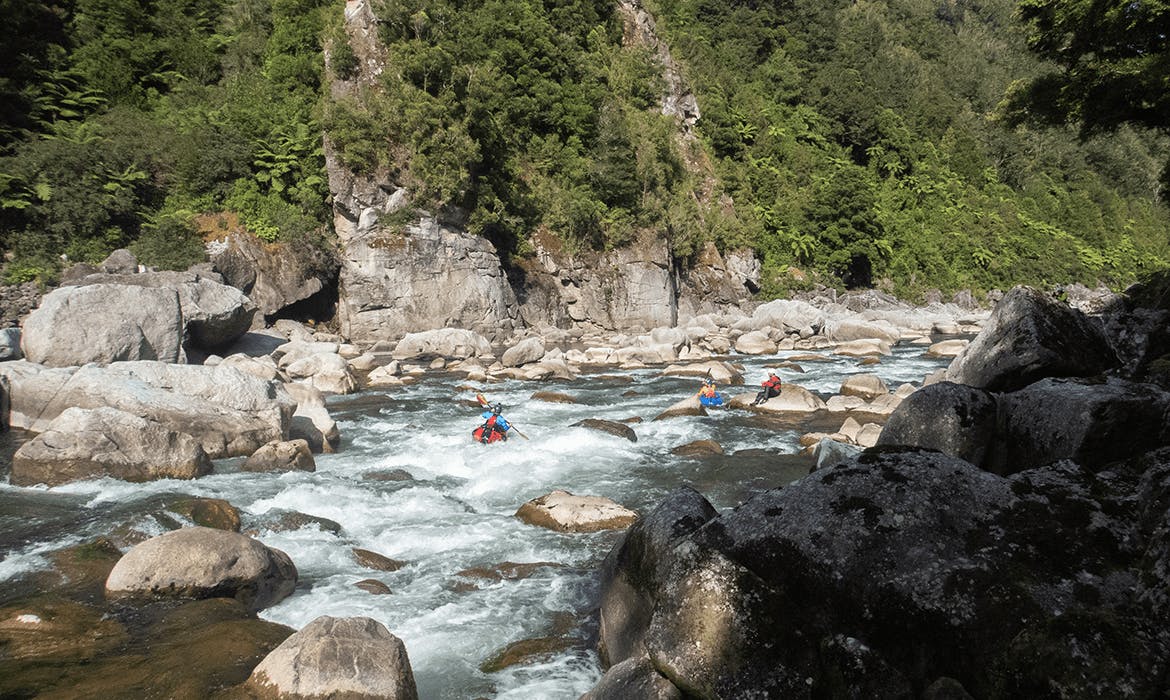
By the time John and the team decided it might be a jolly good adventure to tube raft it from the Wangapeka track in 1974 part of it had been claimed to be run by a couple of other parties in ex WW2 Air Force life rafts or canvas canoes*. The river had been well visited mostly by deer cullers but also in the rush to have a go at any semblance of gold prosperity.
The river in places is severe due to huge earthquake slip rapids from limestone boulders which form some of the biggest sieve conditions. The largest of these slip rapids is downstream of 2 larger tributaries the Beautiful River and the Roaring Lion, this is the name that the rapid at the end of the backed-up lake is called, and aptly so.
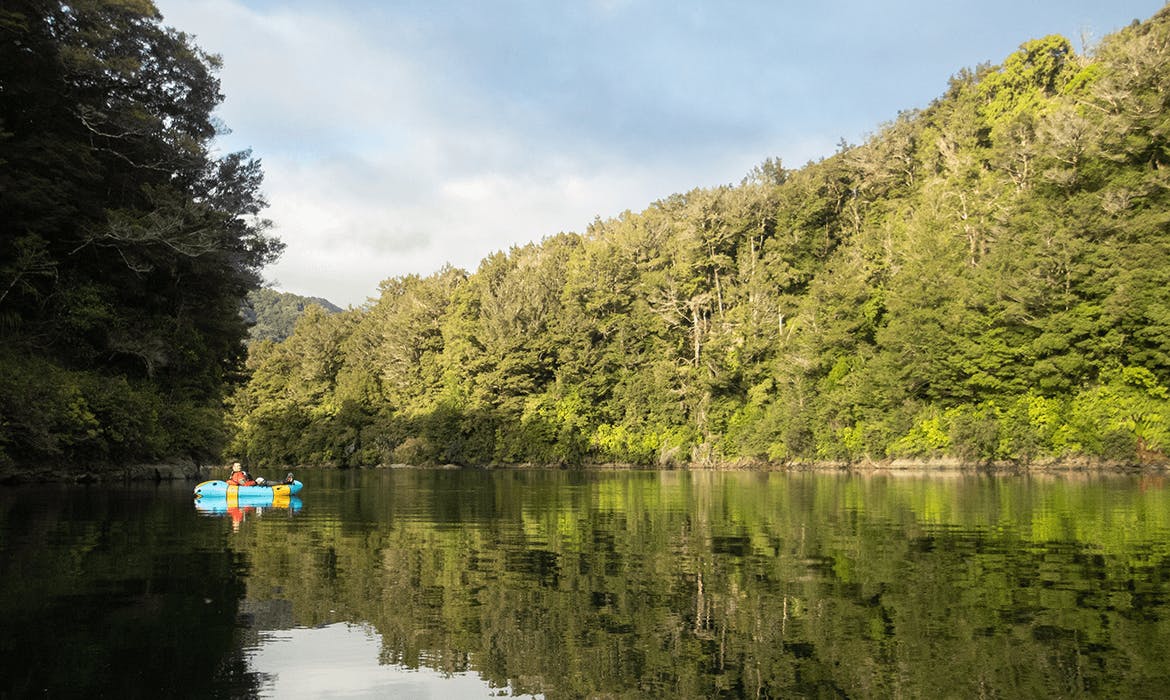
When we arrived at Roaring Lion Rapid we were on plan and had groveled through the 2.5-day hike from the Little Wanganui road end and slipped and slid through the upper river and the many boulder garden rapids rueing the lost opportunity to have more water but also feeling very fortunate to have packrafts and not be struggling with tube rafts. Of note is on John’s trip in the upper river they had left their fully laden packs on the walking track or huts and floated and humped their rafts downstream then walked back up for their packs.
The river was very low and this exposed the many places where the water just disappeared amongst the rocks and made sections completely un-runnable but conversely, the usual added sticky hydraulics of bigger flows turned into narrow slots for our little boats. Most parties deflate and walk the high line away from the risks of the entire almost kilometre-long section but I had already decided that we were going into it at river level to run what we could and do the old school river level portage lines.
When John’s team got here they must have wondered if they would make it out and negotiating any of the Roaring Lion would have been nuts. By now they had run out of any food they had brought with them and were relying on smoked venison strips from the one animal one of the team had shot and eel, and more eel…
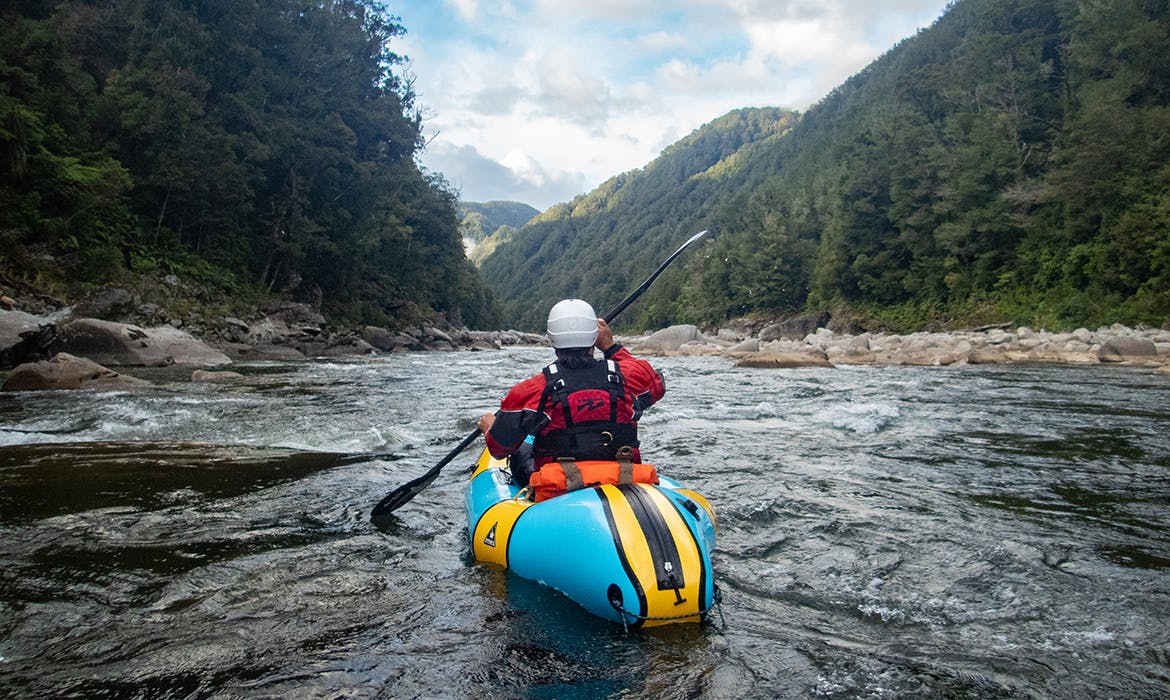
In Wild Rivers, John talks about the proliferation of eels in the rivers and the folklore of culling them with chainsaws by the track construction crew. In the 90’s whilst bringing folk to the Tasman Wilderness Area for rafting expeditions a sole commercial eel fisherman would hold them in nets tied to the drowned trees on the Earthquake Lakes until he had enough to fly out for the canned jellied eel market. We weren’t looking for eels, and didn’t see many either. I was stoked to bag the one shot of a tuna (Te Reo, Maori name) from the river with the dialogue from Muel “I wonder when they swim off to Tonga and die”, that’s what they do.
It was an obvious decision to include a woman on the team to break up the sausage fest and I had formed an online chat with Megan Dimanzantos on her thirst for knowledge of packrafting as she added the genre to her impressive list of activities and accomplishments in many outdoor activities. Now the president of the Federated Mountain Clubs (FMC).
The Karamea was going to be a step up for Megan. On the upper river, Megan had got in the swing of the pinball game. The guts of Roaring Lion caught her out but a textbook throw bag rescue from Muel and Megan’s ability to re-gather her boat meant it was all sorted in no time. I was reassured of the team we’d put together.
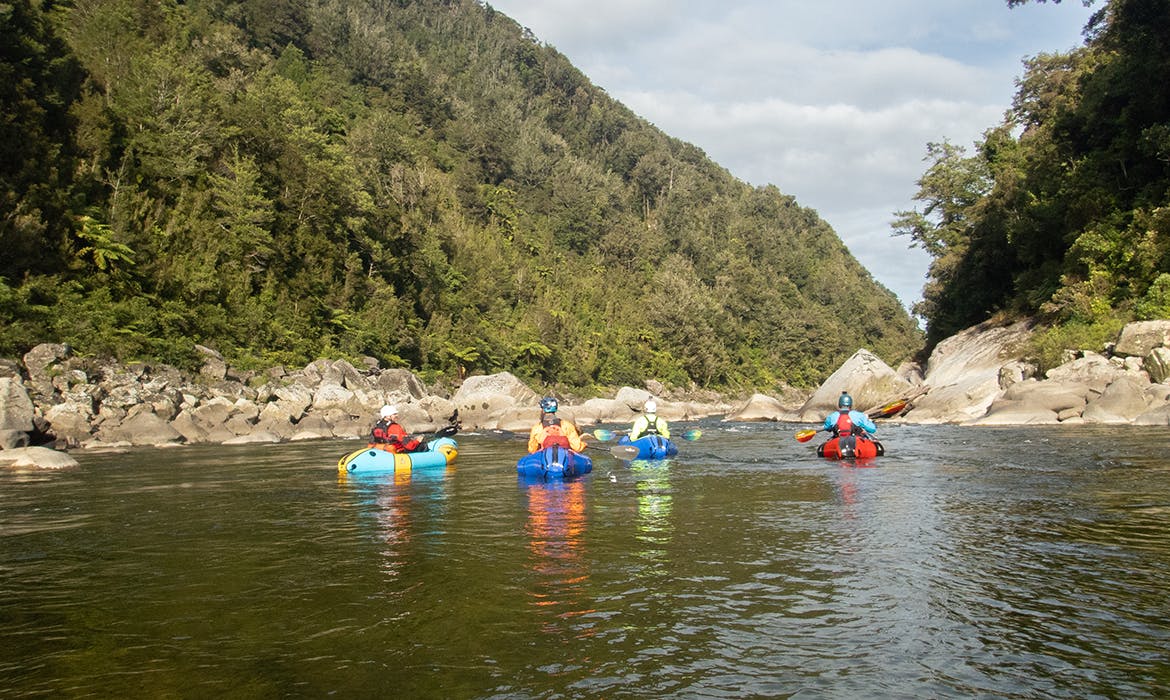
After Roaring Lion, the river narrows and heads into the Gorge. The rapids are closer together and they get bigger as you go. We spent our final night in a hut beside the thunder of Grey's Maze with the final day to come and the biggest rapids. In 1974 the tube raft team was at the end of its tether at this point but they were travelling at the same speed as we were albeit by the sounds completely out of control. They ended up taking 13 days in total we took 6.
We had no major issues and no gear failures. Everyone apart from Muel swam, probably mine in the biggest rapid of the gorge, Holy Shit after filming the crew and shrugging off someone covering a narrow slot drop from shore was the scariest.
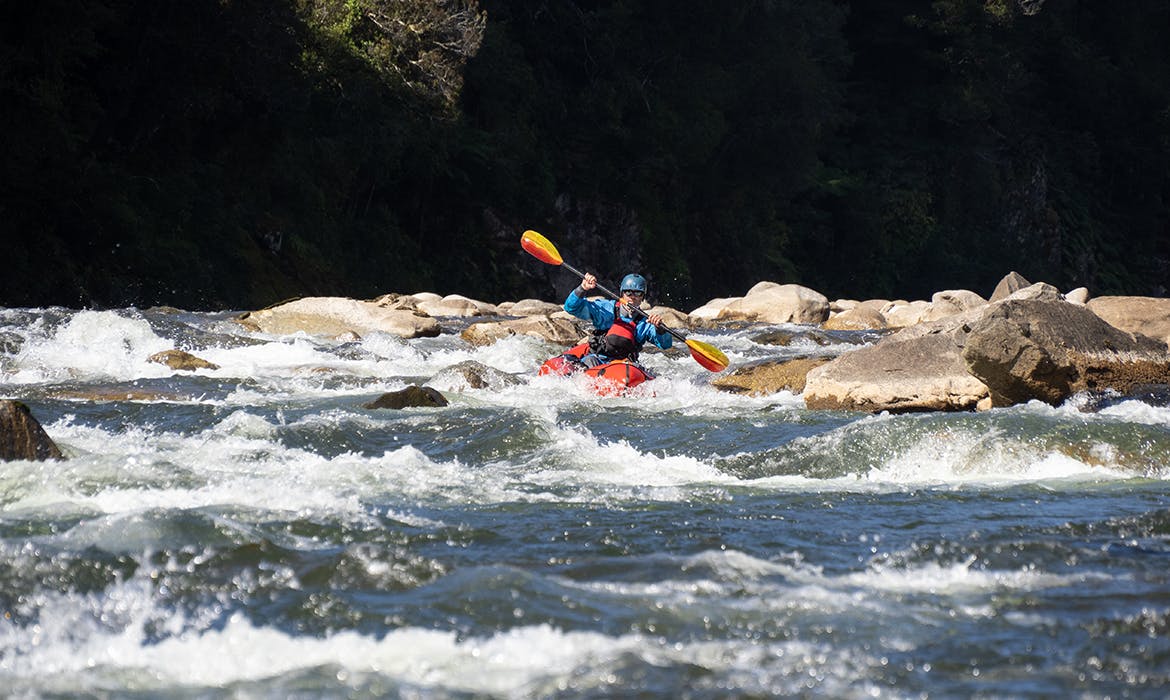
The Wangapeka - Karamea loop is an exceptionally good advanced packrafting trip of 5-7 days. The river needs respect due to the high rainfall area but it's inundated with DoC huts to shelter and it's possible to do the whole loop with a hut every night and not carry much camping gear. There is a good guide to the river on packraftingtrips.nz.
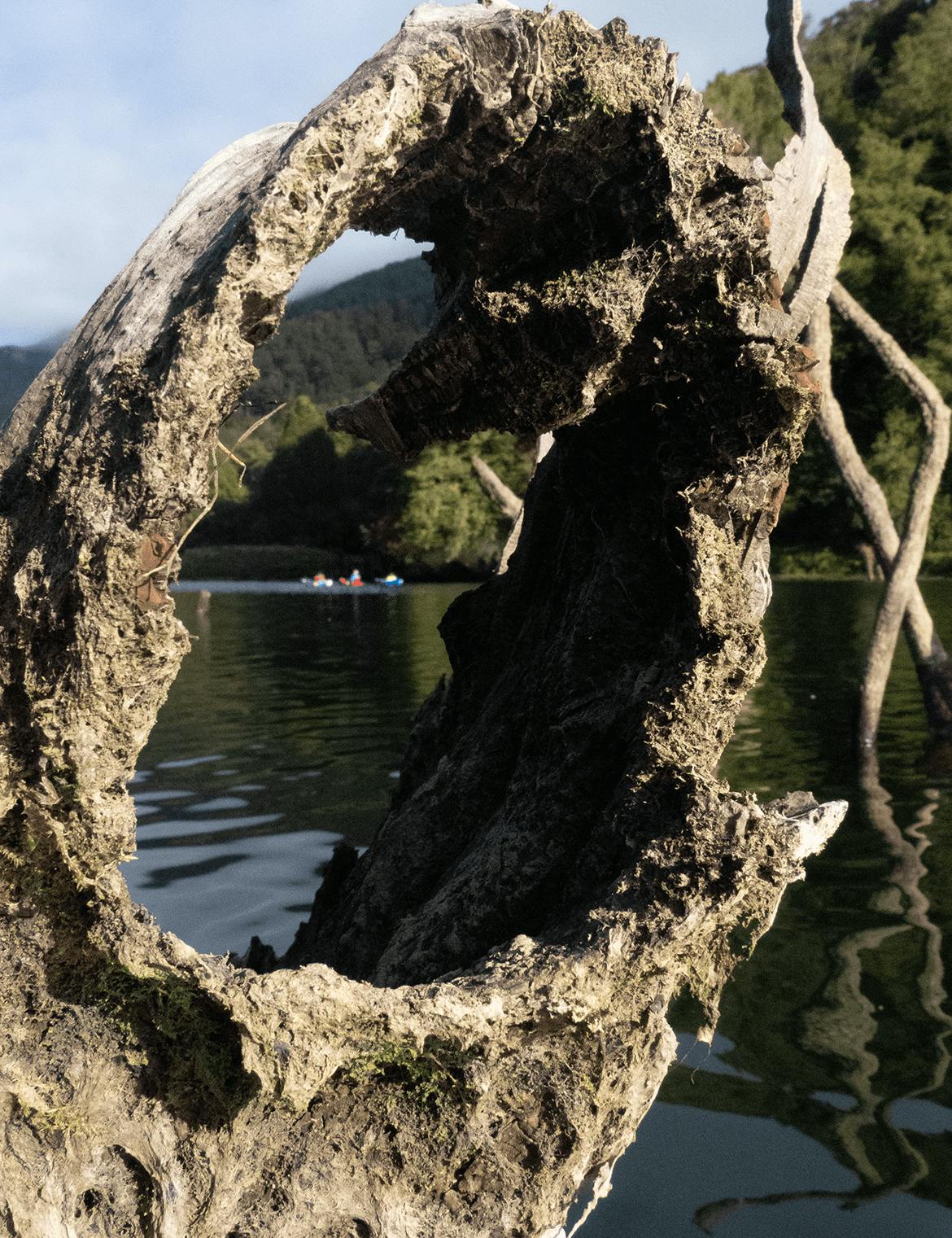
It was an honor to work with John Mackay on this project and be able to learn and capture the reenactment scene. He’s a legend and I wanted to give him the last word.
I’m still not sure whether Deane understands that I’m not keen like him – keen to push myself hard (but safely of course!). The truth is that I didn’t like those old backpacks – no shoulder pads, no waist straps, a hard frame grating the small of your back. My vision was to float lazily and comfortably through the wilderness.
We did have half a day of that sort of bliss on the Karamea but the rest of the twelve days? TBH I did know the expedition was going to be hard yakker (but by then I had a publisher contract and this was to be the final chapter – a first descent through beautiful back-country). It’s just that I had no idea how hard. I would have given up early on but my mate Piers is made of sterner stuff. Even he was exhausted by the time we were committed to the trackless Main Gorge and the weather, which had been perfect until then, began to pack it in.
Half a century passed and I thought history had passed me by. The mad exponential dam-building rush has largely given way to concerns about the quality of river water (We used to safely drink the water from the rivers as we paddled).
Kayaks have evolved from canvas to plastics and someone invented creek boats. Younger generations of kayakers have developed mind-blowing skills and now helicopter into the Southern Alps to drop through the steep West Coast canyons that I’d dismissed as inaccessible and unrunnable.
So I was flattered when a young woman contacted me one day and said she’d read my book. We had coffee and she urged me to come to one of the annual Packraft Meetups. Eventually, I did. Hugh Canard told me that there was a guy called Deane Parker who was planning to do some sort of re-enactment of our Karamea trip. When I contacted him he was surprised I was still alive. But pleased that he could rope me into his vid.
So it’s kinda come a full cycle. The hard-shell kayakers have gone off into different stratospheres but these amazing light sophisticated packrafts have re-ignited recreation on the rivers we used to paddle half a century ago. And then, beyond mountain passes, there are other rivers and Fiordland lakes that no one has ever paddled on. So a new generation can experience the thrill of exploration that we had in the past.
If you haven't yet, head back up to the top of this page to watch the film. Or click here.
